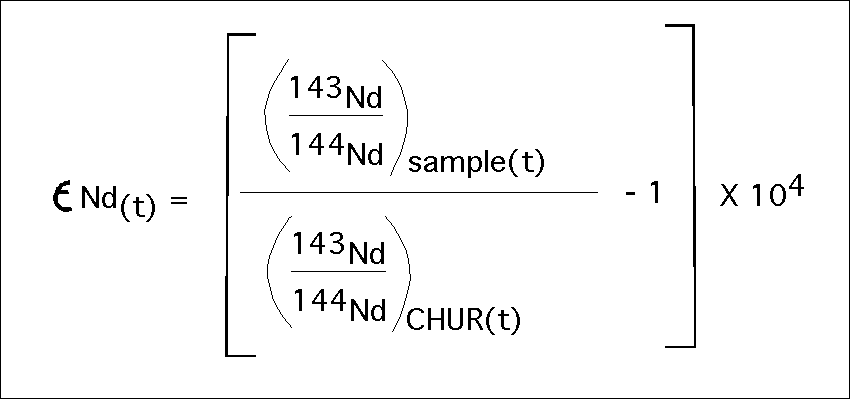 Eqn 1: I is the initial abundance and t is the age of the system.
Eqn 1: I is the initial abundance and t is the age of the system.
Neodymium systems
element info:
Neodymium isotopes are a common daughter product of the decay of Samarium, a rare earth element (REE). REE's are extremely concentrated in melt compared to the concentration of them in mineral form. Another way to portray this concept; REE's are "incompatible" elements in the melting of a mantle peridotite. The partial melt created from crystal-liquid ractionation will be enriched in REE's, but the crystalline phases will be depleted of the incompatible elements. Also, the crust that is formed from this melt will be enriched in REE's. Neodymium is also a light REE, and also common in peridotitic minerals such as plagioclase and pyroxene.
Sm-Nd:
Samarium and Neodymium are good isotopes to study because they are not liable to become chemically disturbed (like Rb-Sr) and they are found in pyroxene and plagioglase (Best, 1982). 147Sm decays to 143Nd with a half life of 106 Ga. In the general decay equation, the Sm-Nd decay is:
.  Eqn 1: I is the initial abundance and t is the age of the system.
Eqn 1: I is the initial abundance and t is the age of the system.
The abundance of the daughter product (143 Nd) is described as the ratio 143Nd / 144Nd. 144 Nd is the stable isotope of Neodymium. This equation is easily derived by dividing eqn 1 (above) by the stable Neodymium counterpart of the same form:
 Eqn 2:
Eqn 2:
This ratio is used to determine the crustal model age of the sampled rock. Archaen pluton have very similar Nd ratios to the Chondritic Uniform Reservoir (CHUR) (Dickin, 1995). The initial Nd ratio of a rock is represented as a deviation from the CHUR evolution line:
 Eqn 3.
Eqn 3.
Negative episolon Nd (ENd) values are indicative of long term light REE enrichment, such as in continental crusts. ENd(0) is the present day value that one would measure. Positive ENd values (+7 to +12)are reflective of mid-ocean ridge basalts (MORB's) or ocean island basalts (OIB) (Reed et al., 1993). Because the crust is continuously sampling the mantle, the mantle becomes more depleted in Sm-Nd over time. Model ages of formation of crust are based on the depleted mantle curve (from Bennet and DePaulo, 1987):
CF=crustal formation
The depleted mantle curve is described by:
 Eqn
4.
Eqn
4.
Thus, END values can be extrapolated back to the depleted mantle curve to determine the age that the crust formed and the Neodymium was placed in crystal form. If there was no contamination then the TDM (depleted-mantle model age or crustal model age) would be derived from eqn 4, knowing ENd (at time of crystallization or crustal formation). If there was contamination, as shown in the figure, the ENd value will be different than that predicted for a pure system.